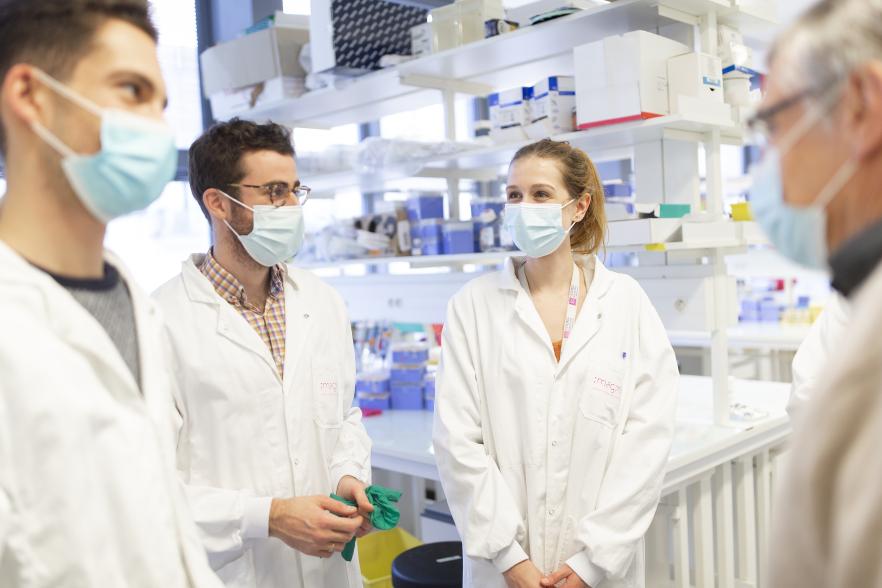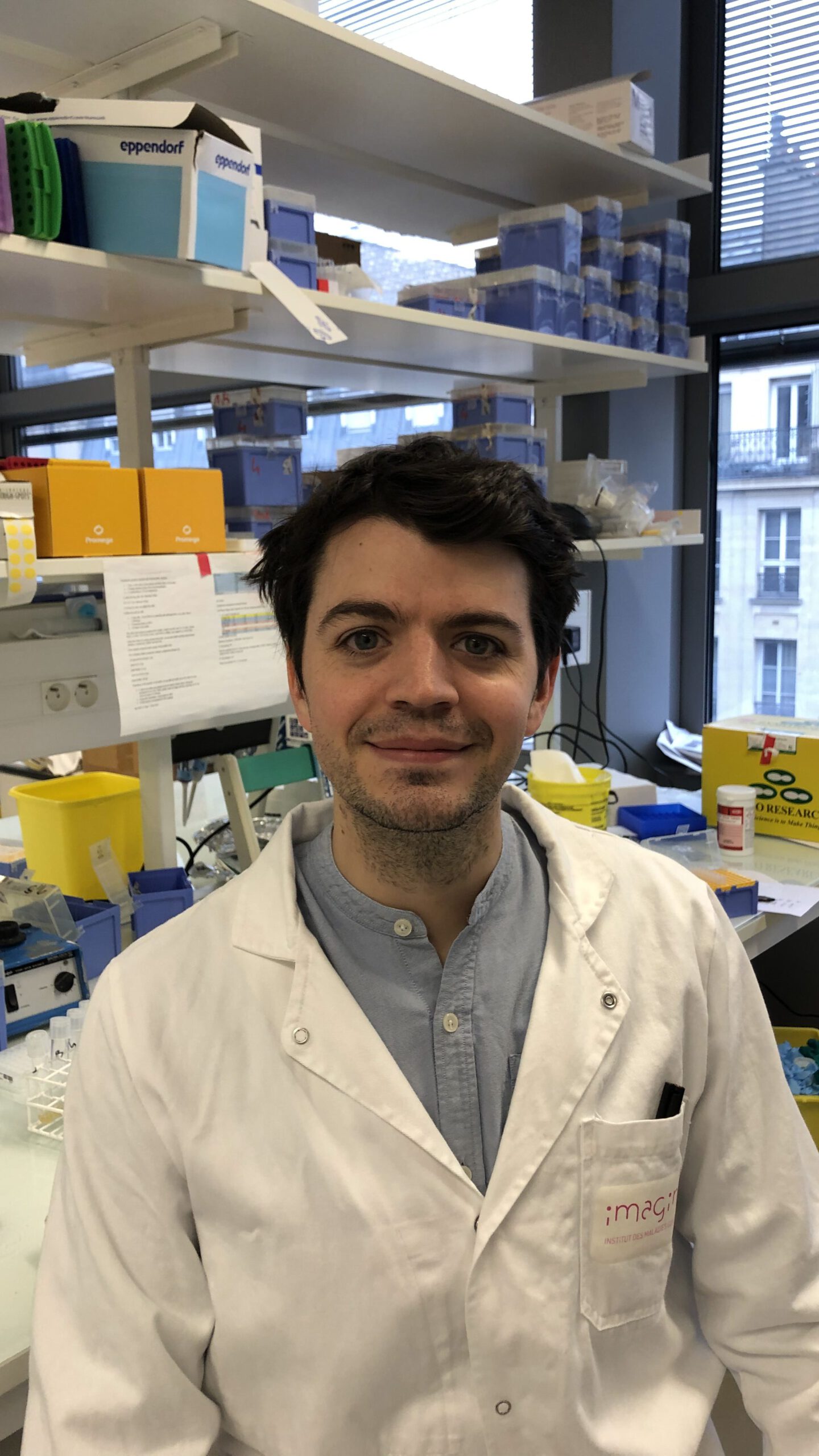Research
A multidisciplinary research approach
Our laboratory employs a diverse array of methodologies to discover the causes and mechanisms of severe or fatal illness in some individuals during their initial infection, contrasting with the resilience of most people to the same infection. To efficiently address this challenging question, our lab is structured into five collaborative research teams, each dedicated to investigating specific themes (three infections, a mechanism of disease, and a methodological approach).

Brain and Lung Viruses
Viral pneumonia
Some children are born with genetic disorders causing them to be highly susceptible to specific respiratory viral infections. In 2015, the HGID lab discovered the first genetic etiology of influenza pneumonia, caused by deficiency in IRF7. These patients are otherwise healthy and not susceptible to other common pathogens. Patients with IRF9, TLR3, IFIH1, STAT1, and STAT2 deficiencies were later discovered to suffer from severe influenza pneumonia, as well as other viral infections including herpes simplex encephalitis (HSE) and viral Live-attenuated vaccines (LAVs). These discoveries demonstrated that genetic defects of the type I interferon (IFN) immunity can lead to severe respiratory viral infections, as all of these deficiencies disrupt type I IFN immunity. In 2020, soon after the COVID-19 pandemic, the Casanova lab and other labs discovered that genetic defects of the type I IFN immunity, including IRF7, TLR3, UNC93B1, IFNAR1, IFNAR2, TICAM1, TBK1, IRF3, STAT2, TLR7, IRAK4, MYD88, and TYK2, can lead to severe COVID-19 in both children and adults. Estimated 3% of adults and 10% of children with severe COVID-19 pneumonia carry genetic defects in the type I IFN immunity, some of whom are also susceptible to other viral or bacterial infections. In 2020, autoantibodies neutralizing type I IFNs were also discovered by the Casanova lab to phenocopy the genetic defects described above. Patients with autoantibodies neutralizing type I IFNs suffer from severe viral infections including influenza pneumonia, COVID-19, severe infections of live-attenuated yellow fever vaccine, and other viral infections.
Viral encephalitis
Life threatening viral encephalitis is a major cause of human disease and mortality. Previous studies have focused on the search and characterization of the causal viruses, however the mechanisms by which viral encephalitis develops only in a minority of the infected people remained poorly understood. The HGID lab pioneered the studies of inborn errors of immunity underlying childhood Herpes simplex encephalitis (HSE), that we recently expanded to other viral encephalitis. Over the years, the lab has demonstrated that in up to 10% of the patients studied, forebrain HSE can result from inborn errors of neuron-intrinsic antiviral mechanisms, including those involving type I IFN immunity (due to deficiencies of TLR3, UNC93B1, TRIF, TRAF3, TBK1, IRF3, NEMO, IFNAR1, STAT1, STAT2, TYK2) or type I IFN-independent antiviral pathways (RIPK3, snoRNA31). The lab has also discovered inborn error of RNA lariats metabolism due to DBR1 deficiency, in children with brainstem encephalitis caused by HSV-1, influenza virus, norovirus, SARS-CoV-2, and other viruses. These findings provided proof-of-principle that childhood viral encephalitis in general may result from inborn errors of tissue-specific, cell-autonomous immunity. Lastly, the lab discovered that autoantibodies neutralizing type I IFNs are the cause of West Nile virus encephalitis in about 40% of the adult patients. The investigations of the human genetic and immunological determinants of viral encephalitis will hopefully result in a fundamentally revolutionized understanding of human antiviral immunity in the central nervous system, to provide guidance for the development of new treatment strategies.
- Zhang Q, et al. Inborn errors of type I IFN immunity in patients with life-threatening COVID-19. Science. 2020 Oct 23;370(6515):eabd4570.
- Zhang SY, et al. TLR3 deficiency in patients with herpes simplex encephalitis. Science. 2007 Sep 14;317(5844):1522-7.
- Ciancanelli MJ, et al. Life-threatening influenza and impaired interferon amplification in human IRF7 deficiency. Science. 2015 Apr 24; 348(6233):448-53.
Theme Leaders

Shen-Ying Zhang

Qian Zhang
Skin Viruses
The clinical phenotypes resulting from skin or mucosal viral infection range from asymptomatic infection to invasive cancers. The skin viruses team, co-led by Drs. Emmanuelle Jouanguy, Vivien Béziat, and Romain Levy, studies the genetic determinants of unusual mucocutaneous viral infections in humans, concerning their severity, recurrence and/or dissemination. The team focuses on herpesviruses (HSV-1, VZV), human papillomaviruses (HPVs), oncoviruses, and Merkel cell polyomavirus (MCPyV). Through an international network of collaborators, we recruit patients with Kaposi sarcoma (KSHV/HHV8), Merkel carcinoma, severe herpes and severe mucocutaneous HPV-driven phenotypes, including recalcitrant warts, epidermodysplasia verruciformis, “Tree man” syndrome, respiratory papillomatosis, and Buschke-Löwenstein tumors. Our team aims to understand the pathogenesis of muco-cutaneous virus-driven phenotypes via the discovery and characterization of monogenic inborn errors of immunity (IEI) using high-throughput sequencing (whole exome/genome sequencing, RNA sequencing). Candidate genetic variants underlying these diseases are validated using a combination of molecular, cellular, and immunological approaches. We also employ several cutting-edge technologies, such as mass cytometry, imaging mass cytometry (IMC) couple to artificial intelligence-based analytical approaches, and single cell RNA sequencing. Our investigations dissect the hematopoietic and non-hematopoietic contributions in the muco-cutaneous virus-driven phenotypes.
- Lévy R, et al. Human CARMIL2 deficiency underlies a broader immunological and clinical phenotype than CD28 deficiency. Journal of Experimental Medicine. 6 February 2023; 220 (2): e20220275.
- Béziat V, et al. Humans with inherited T cell CD28 deficiency are susceptible to skin papillomaviruses but are otherwise healthy. Cell. 2021 Jul 8;184(14):3812-3828.e30.
- de Jong SJ, et al. The human CIB1–EVER1–EVER2 complex governs keratinocyte-intrinsic immunity to β-papillomaviruses. Journal of Experimental Medicine. 3 September 2018; 215 (9): 2289–2310.
Theme Leaders

Vivien Béziat

Emmanuelle Jouanguy

Romain Levy
(also oversees therapeutic programs)
Autoantibodies to Cytokines
Co-lead by Drs. Anne Puel, Paul Bastard, and Tom Le Voyer, the autoantibodies to cytokines team studies the phenocopies of inborn errors of immunity (IEI), by studying neutralizing autoantibodies (auto-Abs) against cytokines, such as potent anti-viral molecules and type I interferons (IFNs). We have identified that these auto-Abs underlie at least 15% of the cases of life-threatening COVID-19 and other viral diseases, including but not limited to, severe influenza, adverse reactions to yellow fever live attenuated vaccination, West Nile virus encephalitis. We have tested over 40,000 individuals between the ages of 0 -100 years old and found that the prevalence of these auto-Abs increases with age. Other known pathogenic auto-Abs neutralizing cytokines include neutralizing auto-Abs against GM-CSF underlying pulmonary alveolar proteinosis and infections (especially cryptococcosis and nocardiosis), auto-Abs neutralizing type II IFN (IFN-γ) leading to mycobacterial diseases or talaromycosis, auto-Abs neutralizing IL-6 causing bacterial infections (staphylococcal diseases in particular), and auto-Abs neutralizing IL-17A/F underlying mucocutaneous candidiasis. Each of these five cytokine auto-Abs underlies a specific range of infectious diseases, phenocopying the infections seen in patients with corresponding inborn errors. We are investigating the characteristics, causes, and consequences of these auto-Abs.
- Bastard P. Why do people die from COVID-19?. Science. 2022;375(6583):829-830.
- Puel A, et al. Comment on “Aberrant type 1 immunity drives susceptibility to mucosal fungal infections”. Science. 2021 Sep 17;373(6561):eabi5459.
- Bastard P, et al. Auto-antibodies against type I IFNs in patients with life-threatening COVID-19. Science. 2020 Oct 23;370(6515):eabd4585.
Theme Leaders

Paul Bastard

Tom Le Voyer
(also oversees
adult studies)

Anne Puel
(also oversees
fungal infections)
Mycobacterial Diseases
Mendelian susceptibility to mycobacterial disease (MSMD) is a group of Inborn Errors of Immunity characterized by severe infections caused by weakly virulent mycobacteria in otherwise healthy patients. All known MSMD-causing genes control the induction and/or the response to interferon gamma (IFN-g), which is the macrophage-activating factor (MAF). In the past five years, we have expanded our collection samples of MSMD patients and have continued to discover new MSMD-causing genes by genome-wide screening approach. We have identified 12 new genetic etiologies of MSMD, including mutations in 10 new genes (IL12RB2, IL23R, SPPL2A, IFNG, TBX21, ZNFX1, IRF1, USP18, MCTS1 and CCR2). We also identified new patients in known genetic MSMD disease. Remarkably, the genetic etiology remains elusive in about half of MSMD patients studied in our laboratory. The investigation of MSMD paves the way for the identification of the first genetic etiologies of tuberculosis (TB) caused by the more virulent Mycobacterium tuberculosis (Mtb). In the last five years, we discover five novel TB-causing genes, including mutations in three novel genes, ZNFX1, PDCD1 and ITK and two novel allelic etiologies, with rare and common AR TYK2 deficiency underlying TB. Particularly, we have shown that homozygosity for the TYK2 P1104A variant is the first-ever common monogenic cause of TB and can underlie a sizable proportion of TB cases [∼1% of TB cases (about 10 million death) in Europeans over the last 2,000 years]. Rare and common genetic etiologies provide a proof-of-principle that TB can be monogenic in a sizeable proportion of cases. TB in other individuals, who do not carry mutations in the known mycobacterial-predisposing genes, may therefore result from other single-gene IEI against Mtb, probably but not necessarily related to the IFN-g. These studies of MSMD and TB have validated our “rare-to-common” approach to discover common determinants of infections from the study of rare disorders of immunity.
- Ogishi M, et al. Inherited human ITK deficiency impairs IFN-γ immunity and underlies tuberculosis. Journal of Experimental Medicine. 2023 Jan 2;220(1):e20220484.
- Ogishi M, et al. Impaired IL-23-dependent induction of IFN-γ underlies mycobacterial disease in patients with inherited TYK2 deficiency. Journal of Experimental Medicine. 2022 Oct 3;219(10):e20220094.
- Neehus AL, et al. Human inherited CCR2 deficiency underlies progressive polycystic lung disease. Cell. 2023 Dec 20:S0092-8674(23)01323-5.
Theme Leaders

Stéphanie Boisson-Dupuis

Jacinta Bustamante

Jérémie Rosain
(also oversees diagnostic studies)

Guillaume Vogt
Computational Genetics
Our computational genetics team, co-lead by Drs. Aurelie Cobat, Bertrand Boisson, and Peng Zhang, is dedicated to identifying candidate variants underlying human infectious diseases. Employing large-scale sequencing of patient cohorts, we tackle challenges in optimal selection of variants through the development of new methods at both variant and gene levels, and the rigorous statistical analysis of cohorts of patients assuming different genetic hypotheses. Recently, we established two variant-level software tools, BPHunter and AGAIN, for genome-wide detection of promising intronic variants that could disrupt canonical splicing, leading to loss-of-function gene products. Our focus extends to deciphering the non-coding variants in deep introns and 5’/3’-untranslated regions that could be functionally significant. We also developed cohort-based statistical approaches to test for alternative genetic hypotheses, such as the network-based heterogeneity clustering (NHC) to unravel physiological homogeneity in the presence of genetic heterogeneity, and a case-only association test to detect digenic inheritance. We developed and optimized several other approaches to improve genetics studies, including PopViz, SeqTailor, GMUSCLE, HMZDelFinder, GDI, MSC, iMUBAC. Our computational team works closely with the experimental team to achieve the scientific mission of the lab, contributing to the study of the genetic component of viral (e.g. COVID-19) and bacterial (e.g. Tuberculosis, Staphylococcal infections) phenotypes. We are also investigating the genetic basis and contribution of auto-Abs to IFNs and other cytokines to several infectious phenotypes and studying the immune genes and their variations in evolutionarily distant vertebrates.
- Zhang P, et al. Genome-wide detection of human variants that disrupt intronic branchpoints. Proceedings of the National Academy of Sciences USA. 2022;119(44):e2211194119.
- Zhang P, et al. A computational approach for detecting physiological homogeneity in the midst of genetic heterogeneity. American Journal of Human Genetics. 2021;108(6):1012-1025.
- Manry J, et al. The risk of COVID-19 death is much greater and age dependent with type I IFN autoantibodies. Proceedings of the National Academy of Sciences USA. 2022;119(21):e2200413119.
Theme Leaders

Bertrand Boisson
(also oversees pyogenic infections)

Aurélie Cobat

